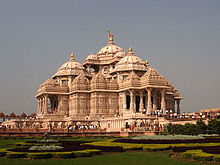Many ethnic groups and cultures are represented in Delhi, making it a cosmopolitan city. Being the political and economic hub of northern India, the city attracts workers – both blue collar and white collar – from all parts of India, further enhancing its diverse character. A diplomatic hub, home to the embassies of 160 countries, Delhi has a large expatriate population as well.
According to the 2011 census of India, the population of Delhi is 16,753,235. The corresponding population density was 11,297 persons per km², with a sex ratio of 866 women per 1000 men, and a literacy rate of 86.34%. In 2004, the birth rate, death rate and infant mortality rate (per 1000 population) were 20.03, 5.59 and 13.08, respectively. As of 2007, the National Capital Territory of Delhi had an estimated population of 21.5 million people, making it the second largest metropolitan area in India after Mumbai. According a 1999–2000 estimate, the total number of people living below the poverty line, defined as living on $11 or less per month, in Delhi was 1,149,000 (which was 8.23% of the total population, compared to 27.5% of India as a whole). In 2001, the population of Delhi increased by 285,000 as a result of migration and by an additional 215,000 as a result of natural population growth – this made Delhi one of the fastest growing cities in the world. By 2015, Delhi is expected to be the third-largest agglomeration in the world after Tokyo and Mumbai.Dwarka, Asia's largest planned residential colony, is located within the National Capital Territory of Delhi.
Hinduism is the religion of 80% of Delhi's population. There are also large communities of Muslims (10%), Sikhs (7.9%), Baha'i(0.1%), Jains (1.1%) and Christians (0.9%) in the city. Other minorities include Parsis, Anglo-Indians, Buddhists and Jews.
Hindustani language is the principal spoken language while English is the principal written language of the city. Other languages commonly spoken in the city are dialects of Hindi, Punjabi and Urdu. The linguistic groups from all over India are well represented in the city; among them are Punjabi, Haryanvi, UP, Rajasthani, Bihari, Bengali, Sindhi, Tamil, Garhwali ,Telugu, North-East, Kannada, Malayalam, Marathi and Gujarati.
52% of Delhi lives in slums without basic services like water, electricity, sanitation, sewage system, proper housing etc.
In 2005, Delhi accounted for the highest percentage (16.2%) of the crimes reported in the 35 cities in India with populations ofone million or more. The city also has the highest rate of crime against women (27.6 compared to national average rate of 14.1 per 100,000) and against children (6.5 compared to national average of 1.4 per 100,000) in the country.



No comments:
Post a Comment